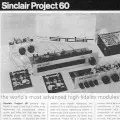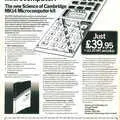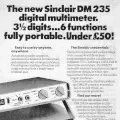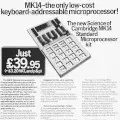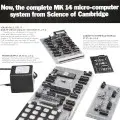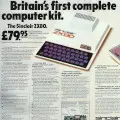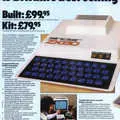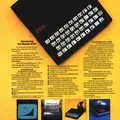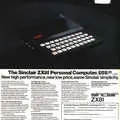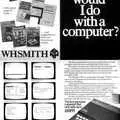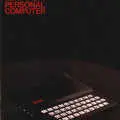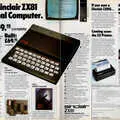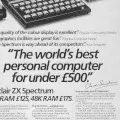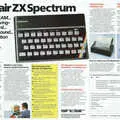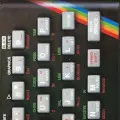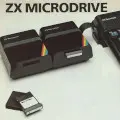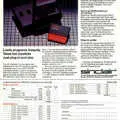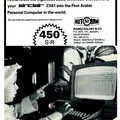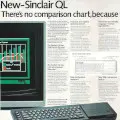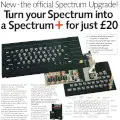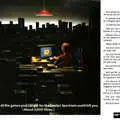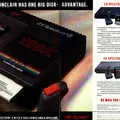
Sinclair Advert - November 1987
From Your Computer
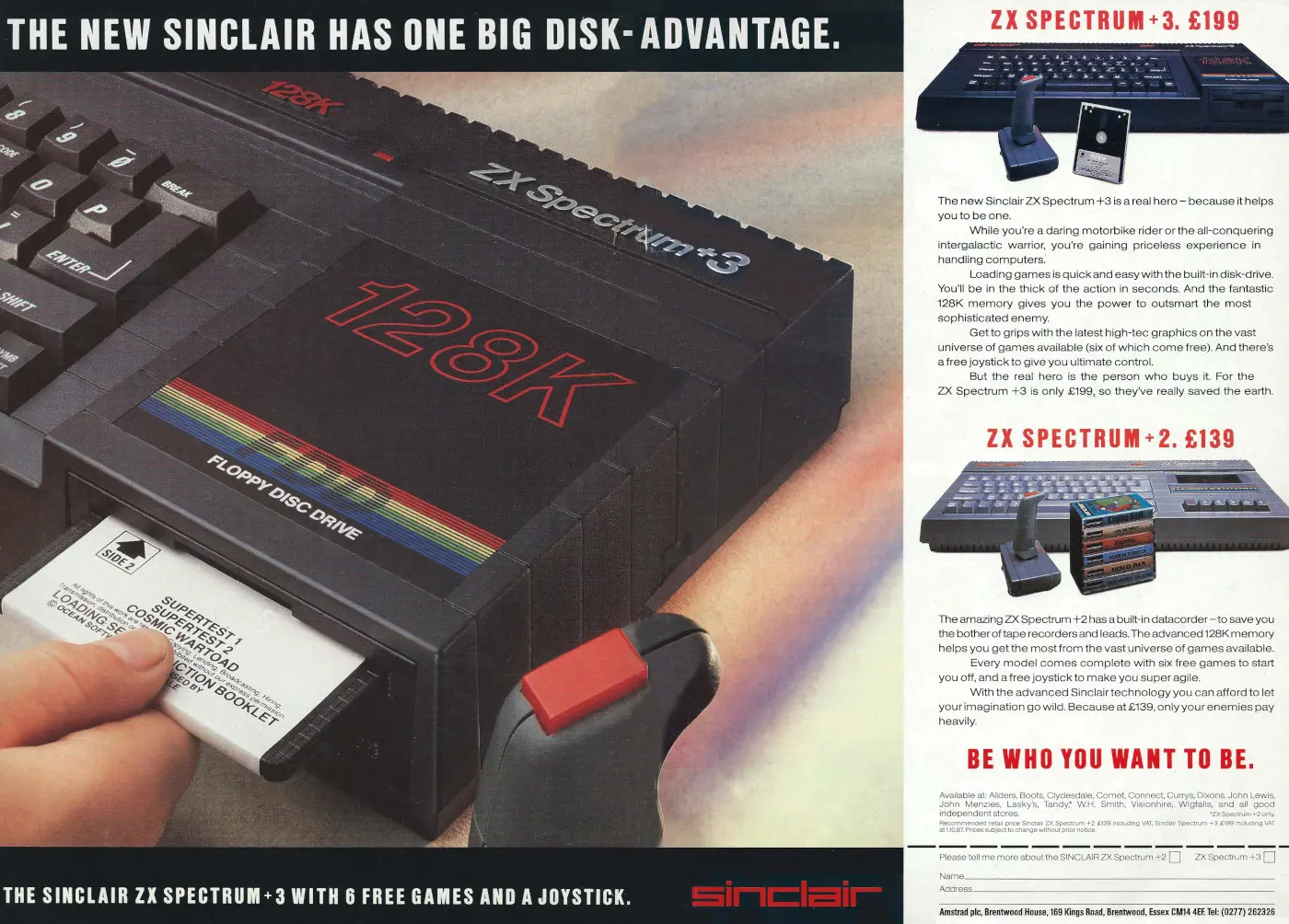
Be who you want to be: The new Sinclair has one big disk advantage
Hot on the heels of the Sinclair 128K +2 Spectrum, released in August of this year, came the +3 version, which had the same slightly-non-standard 3" floppy drive that owner Amstrad used on its other machines like the CPC 6128. Otherwise it was the same machine as the +2 but with a black case.
This was the final Spectrum variant and was produced up until 1990, the date when Amstrad "re-launched" its CPC range.
It retailed for £199, or about £720 in 2025 money, whilst the previous model (the +2) was selling for £139 (£500). The +2B version of the earlier model continued in production up until 1992[1].
The 3" drive had been announced back in 1982. It was produced as a partnership between Matsushita (Panasonic), Hitachi and Hitach Maxell, and at the time it was launched there were no plans to ship it in the UK.
It was designed to be compatible with 5.25" disk interfaces in that it maintained the same rotation speed and disk transfer rates, ostensibly making it an attractive drop-in replacement for the older format[2], with only the cable needing to be changed.
It was also said of the format that its size was chosen not only because smaller disks were more rigid, and thus the read/write heads could be positioned more accurately, but because the Japanese postal system would carry 3" disks - but nothing larger - for the same price as a letter. This made them especially popular in Japan[3].
Whilst the 5.25" format, launched by Shugart, was known as "minifloppy", the 3" disk became known briefly as the "microfloppy" or even "compact disk".
A few months later, in the autumn of 1982, the other "compact disc" technology was launched - a digital music format co-developed by Philips and Sony[4] that came to dominate music distribution until the early part of the 21st century.
In the summer of 1987, when the Spectrum 3 finally received a firm release date of August 1st, high-street retailers appeared initially uncertain about what to do with the thing.
Dixons was committed from the start, and Boots was agreeing to sell it subject to its usual internal technical approval, but WH Smith, which had previously been a staunch supporter of Sinclair products, was still yet to commit.
style="width: 300px; float: left"> style="width: 295px"/>
style="width: 295px"/>
John Rowland of WH SmithSmith's marketing development manager John Rowland said "We're thinking about it, but we're not stocking it immediately", whilst the company was busy shifting Atari's ST and 66XE games console, as well as Sega's console.
Software houses were also non-commital, with many taking a "wait and see" approach, however most seemed to be planning to at least release future programs on both tape and disk.
Mastertronic's Geoff Heath said that his company "[will] produce a reasonable range of disk software", even though company chairman Frank Herman suggested that "There is one drawback from where we sit, in that the price of discs is still too high".
Others questioned the positioning of the Spectrum, with Mark Strachan of Domark - the company that had produced the Living Daylights game, based on the James Bond film of the same name - pointing out the Spectrum 3+'s summer price of £250. He suggested
"Well, the ST is only £200 more and I think I know what people will do. Is it really worth it just to have a disk drive on the Spectrum?"[5].
Despite the cynicism, the Plus 3 did have an effect on Amstrad, as it marked the effective replacement of Amstrad's own CPCs as the company's "leisure micro" offering, as thanks to its older technology the +3 remained cheaper than the colour CPC 6128 by £150.
Software houses had also been suggesting that the games market for the CPC series was "dormant" and WH Smith was looking to drop the CPC 464 and CPC 6128 to push the Atari ST instead.
Whilst it wasn't thought likely that the disk drive would do much itself to improve the availability of games - disk-based games had caught on a little on Commodore's 64 but not really on Amstrad's machines, and "bigger" games for the Spectrum 128 had not really appeared - it did offer the tantalising possibility that the machine might finally get some real small-business use.
This was largely thanks to its real keyboard and the possibility of running CP/M, something which had made the PCW8256 a huge success - despite the fact that the Spectrum's 32-column screen wasn't directly compatible with CP/M's 40- or 80-column modes.
The bundled disk drive, which finally offered an affordable alternative to the curse of the Microdrive and gave many Spectrum users their first taste of high-speed data access[6], got something of a boost when Alan Sugar announced that the price of 3" discs was coming down.
Activision's managing director Rod Cousens suggested that the price drop made targetting the Plus 3 more "viable" but that "I don't think you'll see many new developments going onto it. but we'll certainly put on some existing catalogue for the machine".
Firebird's Tom Watson was more pessimistic, suggesting that Amstrad had taken the wrong approach with the Plus 3, saying "Throwing resources at a machine is a bit risky when it will take an undefined slice of the market".
Amstrad's apparent reticence in providing details about the new Spectrum to developers didn't seem to be helping it either, if comments from Tim Langdell of The Edge were anything to go on, as he said "I don't know of any other company in the UK that supports 128K machines to the same extent that we do [but] we're dying to have more information from Amstrad"[7].
Along with the price cut to around £1 per disc - similar to the price of the 5¼" floppies used by Commodore and BBC machines, and cheaper than the newer 3½" floppies - Amstrad was also keen to point out that despite the virtual demise of the format in the Far East, the company had a stash of "several million" discs available to it[8].
This was news which would presumably stave off uncertainty over future availability of the format that by now no-one else was using.
The issue had been serious enough that Amstrad circulated a letter to its dealers back in the spring of 1986 informing them that "reports of shortages of 3" discs are 'myths'".
Amstrad had gone as far as to request a written letter of confirmation of availability from its supplier Matshushita, although the letter came with the caveat that it would continue to produce them "as long as Amstrad requires them"[9].
style="width: 150px; float: right"> style="width: 145px"/>
style="width: 145px"/>
Nick Alexander of Virgin, © Popular Computing Weekly 29th September 1983The Christmas of 1987 marked the moment when the wider micro industry seemed to have recovered from the crash of 1984 and the shake-outs of 85/86, with both software and hardware staging a recovery.
The +3 cropped up in a mention from software house Mastertronic - the company which had forecast that compilations would be a big thing for the machine - when its spokeserson Rachel Davies said "The [Sinclair] titles have been selling like hot cakes and we've had difficulty keeping up with the demand for our labels such as Ricochet and Americana".
Mastertronic was partly acquired by Virgin in November 1987, when the latter bought a 45% stake in the company for a rumoured £4 million (£14 million in 2025).
Virgin's Nick Alexander took an "advisory" place on the Mastertronic board, but otherwise Virgin was maintaining that it was leaving Mastertronic under its own "autonomous control", with Paul Latham of Virgin saying "The relationship is not only of control, but one of participation", whilst Mastertronic MD Frank Herman said "We are planning to carry on doing what we are already doing"[10].
Elsewhere, Bruce Everiss - once of Oxford Computer Publishing, Abbot Computer Products, Tansoft (the software offshoot of Tangerine/Oric), the infamous Imagine and now Codemasters, and of whom managing director Jim Darling said "Bruce has a proven ability to innovate in the marketplace" and that he would be "a vehicle for our continued growth, thanks to his unsurpassed experience"[11] - was claiming shipments of 30,000 a day, whilst Tynesoft was suggesting that its sales were up 200% on the previous year.
Commodore, which had recently splashed out £50,000 to support athlete Tessa Sanderson, pitched in with "The Amiga is going great guns, we've sold all the ones we've got. We're just concentrating on getting the stuff out"[12].
Atari was also struggling with demand and was facing shortages and grumpy retailers, some of whom had yet to receive a single Atari ST.
It was estimated that there was a global shortfall of 200,000 STs, with 20,000 missing in the UK alone[13].
Date created: 27 November 2019
Last updated: 11 December 2024
Hint: use left and right cursor keys to navigate between adverts.
Sources
Text and otherwise-uncredited photos © nosher.net 2025. Dollar/GBP conversions, where used, assume $1.50 to £1. "Now" prices are calculated dynamically using average RPI per year.
